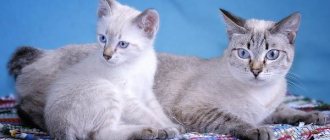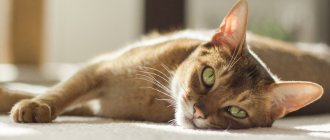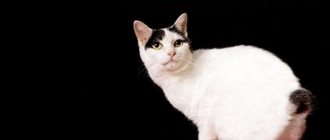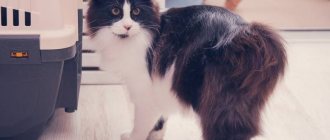Save article:
Bobtail cats
- hunters with excellent qualities, owners of such strong long hind legs and an amazing sense of balance, differ from other cats in the absence of a long tail.
The originality of appearance and friendly character traits have made tailless breeds desirable in many homes around the world.
In general, cats without a tail are divided into Manx and Bobtail cats. And these two groups are divided into subspecies.
There are many versions about how such beautiful cats were born. According to one hypothesis, cats with short tails appeared in the Land of the Rising Sun BC. Much water has passed under the bridge since then, and Japanese Bobtails became an officially recognized breed only at the beginning of the 21st century.
The mysterious Manx breed, which became the ancestor of other short-tailed cats, received its name in honor of the place where it was first discovered - on the Isle of Man, washed by the Irish Sea. From here, cats without a tail began their journey to other countries. It is not known for certain what is more responsible for the modern appearance of the breed - selection or mutation. There is an assumption that Manx cats are descendants of the British shorthair cat.
There is a mythical version about the appearance of tailless cats, which refers us to the Flood: Noah, letting a late cat in, was in a hurry, and inadvertently cut off its tail with the door.
Appearance of a bobtail cat
Bobtail cats are primarily identified by their tail. These cats have a short tail that is one third the length of a normal cat's tail. They have no two identical tails, which are usually 2-10 cm long and can be straight, curved or "spiral".
This breed can be short-haired or long-haired, with thick short fur or long, shaggy hair. Bobtail cats come in all colors and patterns.
Bobtails are a high-shedding breed and are not considered hypoallergenic - in fact, they can cause aggravation in owners with allergies. Cats have long hind legs, a strong athletic body, weight depends on the breed and ranges from 3 to 10 kg.
These cats mature slowly and may take longer than the average cat, 2–3 years, to reach full adulthood. The litter is rarely multiple.
Kitten in the house
Kurilian Bobtail kittens are active and very playful. This breed is relatively new. Its standards are at the approval stage. Therefore, it is important that the breeder is trustworthy and can confirm that the Kurilian Bobtail kitten meets all standards.
The shape of the tail should not be misleading. It can also become deformed in ordinary kittens in the embryonic state. It will be an ordinary cat with an unusually short tail.
When choosing a kitten, you need to look at its color and tail shape. When purchasing, it will not be superfluous to count the vertebrae on the tail. Kurilians have from 2 to 8. The disadvantage of the breed is the tail is up to 3 cm and longer than 8 cm.
Be sure to ask for a veterinary passport for the kitten. Vaccinations and their dates are noted there. The nursery issues a certificate for the kitten. In some cases, a pedigree is given instead. The buyer must necessarily require the conclusion of a purchase and sale agreement. He will confirm the fact of purchase.
Buying a kitten secondhand is always risky. Be sure to carefully examine him and inquire about his state of health. Ears and eyes are carefully examined. They should be free of secretions and parasites. Then the skin and fur are examined. The skin should be clean and the coat should be thick and shiny.
If the kitten is healthy, it is active and inquisitive. He has sparkling eyes. He should not be overly plump or thin. When palpating, the collarbones and ribs should not stand out. A large tail may be a symptom of the presence of worms. The paws need to be examined. Smokers' claws do not fully retract.
What to feed a Kurilian Bobtail kitten
You need to ask the breeder carefully about this. At first they give milk, then you can gradually introduce special food for kittens. It must be Premium class. They switch to it at about 2 months.
A Kurilian Bobtail kitten needs to be fed 5-6 times a day to make it stronger. From three months you can completely switch to cat food. Gradually you need to achieve a balanced diet.
Weight by month
The Kurilian Bobtail should weigh approximately this way as it matures:
- 45 days – 730 g for a cat, 800 g for a cat.
- 2 months – 1100-1500g.
- 6 months – 3 kg for a cat, 4 kg or more for a cat.
- An adult animal reaches a weight of 3.5-5.5 kg in cats, 5-7 in cats.
What to call a smoker
These large animals respond well to short and medium names. For Kuril cats, nicknames should be as masculine as possible. Suitable names for them: Billy, Johnny, Bob, Mebu, Teri, Teddy, Leni, Archie, Ollie, Sad, Chad, Cherry
But names for cats need to be more melodic. They respond well to hissing and dull sounds. Can be named according to color - Tiger, Lynx, Spot.
The following names may be suitable for cats: Bonnie, Sherry, Kitty, Nessie, Emmy, Aida, Obi, Sweetie, Sally, Tilly, Jackie and others.
Bobtail breed temperament
Bobtails are called cute, affectionate and obedient. These pets make excellent companions. They are not aggressive and get along well with children, older people and cat-friendly playmates.
Although this breed is playful, it is not very energetic. You can expect them to want to play every day, but only a little, otherwise they are ready to lie around and snuggle with their owner all day long. Lie by the laptop on the table while the owner types texts, keep your paw on the mouse and try to help your beloved.
True to their laid-back nature, these cats don't have super voices. The Bobtail will make noise when necessary, but you will hear more chirps and trills from it than a full-fledged meow. Attentive to the owner’s speech, the cat tries to repeat the intonation, which is sometimes quite funny.
The main characteristic of a bobtail cat is absolute affection. More than anything else, a bobtail wants to love—and receive that love! If you need a good companion pet, then this breed is suitable.
Gentle felines with short pom-pom tails are ideal for families and are sometimes offered as therapy animals to neurotics.
Hunting character
Short-tailed cats lived on the Kuril Islands for about 200 years; it is not surprising that they are considered hereditary hunters of rats, snakes and hares. There are also canine traits: animals love to run after a toy and return it to its place.
While still a kitten, the bobtail clearly demonstrates its curiosity, sociability, intelligence and ease of learning.
For hyperactive and proactive Kuril cats, it is better to live in private houses with large free spaces and a pond nearby.The animal is not afraid of water, loves to play in it, swim and catch fish with its claws.
The hunting instinct does not prevent cats from being devoted to people and their offspring. Most often, from the entire family environment, animals choose 1-2 owners, to whom they become strongly attached.
Life needs of bobtail cats
Bobtails love to be loved and can give a lot of love in return. These cute cats need constant human interaction and do not do well when left alone.
Important! The Bobtail requires constant affection and cannot be left alone. Loneliness is a great stress for him, during which he behaves completely unpredictably.
If you need to go somewhere, it is better to take your pet with you. Although ordinary cats become attached to a place, not to an owner, and do not like to leave somewhere. Therefore, if you spend a lot of time on the road, you should know that the bobtail travels well and will be an excellent travel companion.
These social cats get along with almost everyone and don't mind homes that are frequented by guests. They rush to the door to greet the guests.
Because cats crave companionship, they will try to make friends with almost anyone—you'll need to keep an eye on your bobtail to make sure he doesn't go outside to meet less friendly animals and people.
To satisfy your kitten's curious nature and social needs, you need to train him to walk on a leash and take him on walks around the neighborhood.
Although bobtail cats are not described as very active, they have a strong, athletic body. Bobtails have particularly muscular hind legs and can jump up to 2.5 meters. Giving your pet a tall cat tree will give him a safe and comfortable place to land when he wants to frolic.
What to feed and pamper
For short-tailed cats, natural or high-quality dry food is preferable. A large amount of hard and hard food is desirable in the diet: bones, chicken stomachs and cartilage.
Feeding a cat raw, clean meat is dangerous; it is better to combine fresh chicken, fish with dry food. Your pet's bowl should always be filled with unboiled water.
Brave and courageous bobtails will become a devoted friend for a person and even an excellent nanny for small children.
- Siberian cat - history of the breed, description, character and habits + 95 photos
- Oriental cat - history of the breed, modern standards, character, care, nutrition + 83 photos
- Maine Coon - history of occurrence, description of the breed, character + 84 photos
With their boundless affection, they are more like a purring dog: they are also faithful, do not leave their home without their owner and follow on his heels everywhere.
Bobtail cat care
Caring for a bobtail is easy. Brushing once or twice a week is necessary to keep the coat smooth and healthy. The brush should be selected based on your pet's coat type. Remember to trim your nails regularly and check and clean your ears regularly in the morning.
The Bobtail is a relatively low-energy breed and does not require much exercise. Owners don't have to go out of their way to get these cats moving, but one-on-one play can be encouraged and appropriate toys offered.
Because they are intelligent, these cats can be easily trained to perform simple tasks such as using a litter box or scratching post. They can also be taught to play games like “Fetch!” and walk on a leash.
Socialization with this good-natured breed should be easy. Bobtails who are introduced early to people and pets usually get along easily and greet unfamiliar faces.
All types of bobtails should be fed cat food recommended by a veterinarian. It is important not to overfeed your cat, as this can lead to obesity.
Bobtail cat health
Bobtails have a lifespan of 13–15 years and are a relatively healthy breed due to their natural development. Cases of being born without a tail can lead to problems with the spine.
Due to the unequal length of the front and rear legs, hip dysplasia, an inherited disease that can cause lameness and arthritis of the hip joints, develops with age.
Tailless bobtails may develop a spinal disorder in old age that will affect their ability to control bowel movements.
Breeders screen kittens for health problems, but it is important that animals are monitored regularly until adulthood. Health problems may go undetected until the very end of a cat's life. Regular examinations by a veterinarian will be the basis for a calm life for the owner and his pet.
Types of bobtail cats
The types of bobtails that are known today began naturally at different times. The photo shows the main varieties of bobtail cats:
American, bred by felinologists in the early 80s. It took two decades to create this variety. Features include striped color, large size, and “knots” of the tail.
Karelian, thick coat with undercoat, close-set eyes, varied color except spots. A successful hunter, a loyal friend, behavior close to that of a dog.
The Kamchatka bobtail cat may have evolved from the Japanese bobtail. Luxurious fur, round eyes.
Mekong, bred in Thailand. Features: small size, characteristic “Siamese” color, slanting blue eyes. Capable of protecting the house like watchdogs.
Manx, a British variety of almost tailless cat, is large, weighing up to 7 kg. The coat is thick and striped in color. The eyes are large and round, creating a surprised look.
The pixie bob, a smaller version of the natural lynx, has a short tail and up to 7 toes on the hind feet, common in Canada and the United States.
Japanese, known since the 16th century, the breed was recognized in 1993. Small specimens weigh up to 4 kg, with a curved tail. The color is white, with black or red spots. The eyes are slanted, wide open, often of different colors.
Origin of breed characteristics
Cats with short tails have been known for centuries. Traditions and legends explain the presence of such a deviation in animals in different ways. In the biblical version, the cat that was late for the ark had its tail pressed against the door. An equally common misconception is that kittens are specifically subjected to surgery to obtain a fluffy pom-pom.
Genetics explained that the birth of individuals without the last vertebrae is associated with a mutation on several chromosomes. Due to the fact that most of the short-tailed breeds were bred on the islands in isolated communities, it was possible to quickly obtain numerous offspring of an unusual appearance.
Manx
Japanese branch
In ancient Japanese beliefs, there is a deity called Nekomata. He has the appearance of a cat with two tails and brings troubles, illnesses and suffering to people. When cats arrived in Japan along with merchant ships, the local population began to cut off the tails of their pets so as not to attract the attention of an evil spirit.
Naturally, selection preference was given to those animals whose tails were shorter than those of their relatives. Gradually, most of the cats on the island turned out to be the owners of a neat fluffy pom-pom.
Japanese Bobtail
All breeds with Japanese roots are called bobtails. In the land of the rising sun itself, they are called maneki-neko and are considered symbols of wealth and prosperity.
Since the economic and political isolation of the islands ended, representatives of unusual cats have spread throughout the world. Their genetic characteristics were used to breed tailless hybrids with other common breeds.
Read more in the article about Japanese bobtails.
British branch
Manx cats originated on the Isle of Man, located near Great Britain. The random mutation quickly spread and was fixed by additional selection. Unusual short-tailed cats became a curiosity and a local calling card and quickly spread from there throughout Europe and America. Externally, the animals are very similar to British Shorthairs. The appearance of rare furry offspring was received with great interest by breeders. Subsequently, a separate subspecies of long-haired Manx was even bred in Canada.
Manx
We recommend reading the article about the Manx breed.
There are other local branches that are of South American or Thai origin. The exterior of bobtails and manxes includes 4 different breed variations:
| Name | Length of the caudal process |
| Rampy | Completely absent |
| Reeser | 1-2 vertebrae |
| Stumpy | 4-8 links |
| Longs | A little shorter than usual |
Rampy Reaser
Stumpy
Longs
Interesting facts about the bobtail breed
Bobtails are like dogs when they wag their short tail to express their happiness.
The difference in the length of the front and hind legs and the short tail make bobtails funny, sometimes they can't keep their balance and just flop down on the floor.
The desire to imitate the owner brings the intonation of the cat’s meow to perfection; it can begin to “talk” to the owner.
Attitude towards other animals
If other animals already live in the family, the bobtail will easily find a common language with them. He is equally welcoming to both cats and dogs, so it will not be difficult for him to establish contact with a mischievous dachshund and a formidable Maine Coon.
However, it is worth noting that the presented breeds categorically cannot tolerate ornamental birds and rodents. This is due to the developed hunting instinct.











